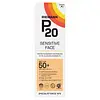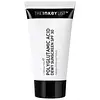What's inside
What's inside
 Key Ingredients
Key Ingredients

 Benefits
Benefits

 Concerns
Concerns

 Ingredients Side-by-side
Ingredients Side-by-side

Water
Skin ConditioningDiethylamino Hydroxybenzoyl Hexyl Benzoate
UV FilterDibutyl Adipate
EmollientBis-Ethylhexyloxyphenol Methoxyphenyl Triazine
Skin ConditioningDicaprylyl Carbonate
EmollientTris-Biphenyl Triazine
UV AbsorberGlycerin
HumectantPhenoxyethyl Caprylate
Caprylyl Caprylate/Caprate
EmollientCanola Oil
EmollientSilica
AbrasivePotassium Cetyl Phosphate
EmulsifyingPanthenol
Skin ConditioningTrehalose
HumectantCetearyl Alcohol
EmollientEthylhexyl Triazone
UV AbsorberVp/Eicosene Copolymer
Phenoxyethanol
PreservativeSqualene
EmollientGlyceryl Stearate
EmollientSodium Olivoyl Glutamate
CleansingSorbitan Caprylate
EmulsifyingTocopheryl Acetate
AntioxidantDecyl Glucoside
CleansingBenzoic Acid
MaskingCaprylyl Glycol
EmollientPropanediol
SolventAcacia Senegal Gum
MaskingXanthan Gum
EmulsifyingSodium Phytate
Tocopherol
AntioxidantDehydroacetic Acid
PreservativeAscorbyl Palmitate
AntioxidantEthylhexylglycerin
Skin ConditioningButylene Glycol
HumectantDisodium Phosphate
BufferingCitric Acid
BufferingBiosaccharide Gum-1
HumectantPotassium Sorbate
PreservativeSodium Benzoate
MaskingGlyceryl Caprylate
EmollientSodium Levulinate
Skin ConditioningSodium Anisate
AntimicrobialSodium Hydroxide
BufferingWater, Diethylamino Hydroxybenzoyl Hexyl Benzoate, Dibutyl Adipate, Bis-Ethylhexyloxyphenol Methoxyphenyl Triazine, Dicaprylyl Carbonate, Tris-Biphenyl Triazine, Glycerin, Phenoxyethyl Caprylate, Caprylyl Caprylate/Caprate, Canola Oil, Silica, Potassium Cetyl Phosphate, Panthenol, Trehalose, Cetearyl Alcohol, Ethylhexyl Triazone, Vp/Eicosene Copolymer, Phenoxyethanol, Squalene, Glyceryl Stearate, Sodium Olivoyl Glutamate, Sorbitan Caprylate, Tocopheryl Acetate, Decyl Glucoside, Benzoic Acid, Caprylyl Glycol, Propanediol, Acacia Senegal Gum, Xanthan Gum, Sodium Phytate, Tocopherol, Dehydroacetic Acid, Ascorbyl Palmitate, Ethylhexylglycerin, Butylene Glycol, Disodium Phosphate, Citric Acid, Biosaccharide Gum-1, Potassium Sorbate, Sodium Benzoate, Glyceryl Caprylate, Sodium Levulinate, Sodium Anisate, Sodium Hydroxide
Water
Skin ConditioningOctocrylene
UV AbsorberGlycerin
HumectantEthylhexyl Salicylate
UV AbsorberCoco-Caprylate/Caprate
EmollientButyl Methoxydibenzoylmethane
UV AbsorberPhenylbenzimidazole Sulfonic Acid
UV AbsorberTriheptanoin
Skin ConditioningSaccharomyces Ferment
Skin ConditioningCetearyl Alcohol
EmollientGlyceryl Stearate Se
EmulsifyingTromethamine
BufferingGlyceryl Caprylate
EmollientPropanediol
SolventC9-12 Alkane
SolventDilinoleic Acid/Butanediol Copolymer
Sodium Stearoyl Glutamate
CleansingHydroxyethyl Acrylate/Sodium Acryloyldimethyl Taurate Copolymer
Emulsion StabilisingDimethicone
EmollientSqualane
EmollientHectorite
AbsorbentLauroyl Lysine
Skin ConditioningHydroxyethylcellulose
Emulsion StabilisingCaprylhydroxamic Acid
Dimethiconol
EmollientPolysorbate 60
EmulsifyingAcrylates/C10-30 Alkyl Acrylate Crosspolymer
Emulsion StabilisingOryza Sativa Hull Extract
MoisturisingCastor Oil/Ipdi Copolymer
Phenoxyethanol
PreservativePolyglutamic Acid
Skin ConditioningSorbitan Isostearate
EmulsifyingCamellia Sinensis Leaf Extract
AntimicrobialIpomoea Batatas Root Extract
Skin ConditioningHydroxyacetophenone
AntioxidantSodium Benzoate
Masking1,2-Hexanediol
Skin ConditioningCaprylyl Glycol
EmollientLactobacillus Ferment Lysate
Skin ConditioningSaccharomyces Lysate
Skin ConditioningWater, Octocrylene, Glycerin, Ethylhexyl Salicylate, Coco-Caprylate/Caprate, Butyl Methoxydibenzoylmethane, Phenylbenzimidazole Sulfonic Acid, Triheptanoin, Saccharomyces Ferment, Cetearyl Alcohol, Glyceryl Stearate Se, Tromethamine, Glyceryl Caprylate, Propanediol, C9-12 Alkane, Dilinoleic Acid/Butanediol Copolymer, Sodium Stearoyl Glutamate, Hydroxyethyl Acrylate/Sodium Acryloyldimethyl Taurate Copolymer, Dimethicone, Squalane, Hectorite, Lauroyl Lysine, Hydroxyethylcellulose, Caprylhydroxamic Acid, Dimethiconol, Polysorbate 60, Acrylates/C10-30 Alkyl Acrylate Crosspolymer, Oryza Sativa Hull Extract, Castor Oil/Ipdi Copolymer, Phenoxyethanol, Polyglutamic Acid, Sorbitan Isostearate, Camellia Sinensis Leaf Extract, Ipomoea Batatas Root Extract, Hydroxyacetophenone, Sodium Benzoate, 1,2-Hexanediol, Caprylyl Glycol, Lactobacillus Ferment Lysate, Saccharomyces Lysate
 Reviews
Reviews

Ingredients Explained
These ingredients are found in both products.
Ingredients higher up in an ingredient list are typically present in a larger amount.
Caprylyl Glycol is a humectant and emollient, meaning it attracts and preserves moisture.
It is a common ingredient in many products, especially those designed to hydrate skin. The primary benefits are retaining moisture, skin softening, and promoting a healthy skin barrier.
Though Caprylyl Glycol is an alcohol derived from fatty acids, it is not the kind that can dry out skin.
This ingredient is also used as a preservative to extend the life of products. It has slight antimicrobial properties.
Learn more about Caprylyl GlycolCetearyl alcohol is a mixture of two fatty alcohols: cetyl alcohol and stearyl alcohol. It is mainly used as an emulsifier. Emulsifiers help prevent the separation of oils and products. Due to its composition, it can also be used to thicken a product or help create foam.
Cetearyl alcohol is an emollient. Emollients help soothe and hydrate the skin by trapping moisture.
Studies show Cetearyl alcohol is non-toxic and non-irritating. The FDA allows products labeled "alcohol-free" to have fatty alcohols.
This ingredient is usually derived from plant oils such as palm, vegetable, or coconut oils. There is debate on whether this ingredient will cause acne.
Due to the fatty acid base, this ingredient may not be Malassezia folliculitis safe.
Learn more about Cetearyl AlcoholGlycerin is already naturally found in your skin. It helps moisturize and protect your skin.
A study from 2016 found glycerin to be more effective as a humectant than AHAs and hyaluronic acid.
As a humectant, it helps the skin stay hydrated by pulling moisture to your skin. The low molecular weight of glycerin allows it to pull moisture into the deeper layers of your skin.
Hydrated skin improves your skin barrier; Your skin barrier helps protect against irritants and bacteria.
Glycerin has also been found to have antimicrobial and antiviral properties. Due to these properties, glycerin is often used in wound and burn treatments.
In cosmetics, glycerin is usually derived from plants such as soybean or palm. However, it can also be sourced from animals, such as tallow or animal fat.
This ingredient is organic, colorless, odorless, and non-toxic.
Glycerin is the name for this ingredient in American English. British English uses Glycerol/Glycerine.
Learn more about GlycerinGlyceryl Caprylate comes from glycerin and caprylic acid, a fatty acid from coconut. It has emollient and emulsifier properties.
As an emollient, it helps hydrate your skin. Emollients work by creating a barrier on your skin to trap moisture in, helping to keep your skin soft and smooth.
On the other hand, emulsifiers prevent ingredients (such as oil and water) from separating.
Learn more about Glyceryl CaprylatePhenoxyethanol is a preservative that has germicide, antimicrobial, and aromatic properties. Studies show that phenoxyethanol can prevent microbial growth. By itself, it has a scent that is similar to that of a rose.
It's often used in formulations along with Caprylyl Glycol to preserve the shelf life of products.
Propanediol is an all-star ingredient. It softens, hydrates, and smooths the skin.
It’s often used to:
Propanediol is not likely to cause sensitivity and considered safe to use. It is derived from corn or petroleum with a clear color and no scent.
Learn more about PropanediolSodium Benzoate is a preservative. It's used in both cosmetic and food products to inhibit the growth of mold and bacteria. It is typically produced synthetically.
Both the US FDA and EU Health Committee have approved the use of sodium benzoate. In the US, levels of 0.1% (of the total product) are allowed.
Sodium benzoate works as a preservative by inhibiting the growth of bacteria inside of cells. It prevents the cell from fermenting a type of sugar using an enzyme called phosphofructokinase.
It is the salt of benzoic acid. Foods containing sodium benzoate include soda, salad dressings, condiments, fruit juices, wines, and snack foods.
Studies for using ascorbic acid and sodium benzoate in cosmetics are lacking, especially in skincare routines with multiple steps.
We always recommend speaking with a professional, such as a dermatologist, if you have any concerns.
Learn more about Sodium BenzoateWater. It's the most common cosmetic ingredient of all. You'll usually see it at the top of ingredient lists, meaning that it makes up the largest part of the product.
So why is it so popular? Water most often acts as a solvent - this means that it helps dissolve other ingredients into the formulation.
You'll also recognize water as that liquid we all need to stay alive. If you see this, drink a glass of water. Stay hydrated!
Learn more about Water